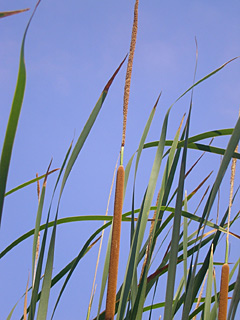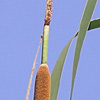Typha domingensis (Lesser Bulrush, Narrow Leaf Cattail) develops a crawling rhizome inside the soil, which contains intracellular spaces that store air, which assist in its respiration in the oxygen-poor environment of the water. Leaves extend upwards from the rhizome nodes and roots extend downwards. The rhizome is also responsible for vigorous vegetative reproduction. Lesser Bulrush has no erect stems, except for the flower spike. The leaves grow straight out of the soil, from the rhizome, and are straight, erect and very long, reaching up to 2 m. They are 1-2 cm wide. What is their secret? How can such a long and thin leaf stand erect? The leaf is indeed narrow, but not flat. Rather, it is thick (4 mm). If we cut the leaf length-wise parallel to its broad side, we will discover a wonderful maze of box-shaped septa, separated by air spaces. The septa afford the leaf mechanical strength, and the air spaces afford passage for oxygen-rich air from the leaves to the rhizome and roots which are immersed in the mud. The leaf twists somewhat around its length, which also adds to its stability.
Lesser Bulrush blooms in the summer, from June to October. The flower spike is the plant's only stem, and it does not carry leaves. It is erect, round, and reaches a height of 2 m. It is not hollow and its inside is filled with a spongy tissue. The flowers are light brown, tiny, unisexual, arranged in a thick spiral at the head of a long flower spike – almost up to its tip. A small part of the stem protrudes above the inflorescence, and becomes pointed at its tip. The general appearance of the inflorescence is ingathered and dense, like a brush for cleaning bottles. The inflorescence has two parts: on the upper part the male flowers, and underneath them the female flowers. There is a space between the female and the male flowers. Pollination is by wind. The female flower has a pappus at its base, which also remains on the fruit and assists in dispersing it to long distances in the wind. The fruit is dry (a nutlet). The inflorescence is picturesque, and some people are tempted to dry it and keep it at home for ornamentation. However, at some stage the inflorescence dries and disseminates hundreds of pappose seeds around the entire house. This may be overcome by spraying the inflorescence with transparent lacquer.
Lesser Bulrush grows practically on the shore of the water body, even penetrates shallow water up to a depth of 30 cm. In the zonation around the water body, Lesser Bulrush is found within the first zone, closest to the water body. It grows in suitable habitats in all parts of Israel. It has a wide worldwide distribution in Africa, Asia and Europe.
The leaves are used for weaving mats and baskets. The pappi of the seeds are used for insulation and for filling pillows. The rhizome is edible. So is the core of the young flower spikes.
The genus contains 10 species. In Israel there are 4 species, 3 of which are very rare. The genus is isolated, the only one in its family, the Typhaceae family, which is included in the order Arecales.
Written by Mike Livne




